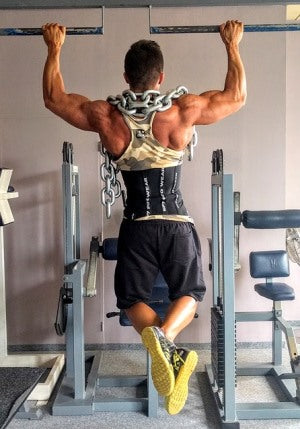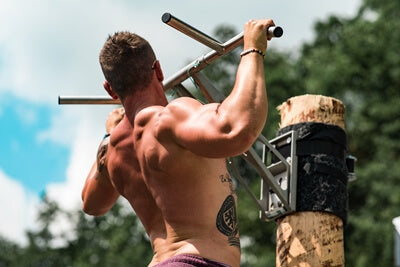Pull-ups are a mixed strength training exercise. The body hangs from a fixed bar with outstretched arms. During the exercise, you pull your body up so that your elbows are bent. Your head is higher than your hands. We will show you exactly which muscle groups are trained in the following article.
Training many muscles at the same time
Want to do something to build muscle? Pull-ups are a suitable way to do this. If you do them at regular intervals, you automatically train different muscles at the same time. While your hands are in a horizontal position on the pull-up bar during training pull-up bar your arms are responsible for pulling up the entire body weight.
The aim of this exercise is for your chin to be above the bar. However, you should be aware that the palms of your hands are exposed to a lot of strain during these training sessions. You can prevent this effect by using sports gloves, grip pads or chalk.
Which muscles are trained during pull-ups?

In general, the arm and upper arm muscles are trained alongside your back muscles. However, pull-ups are not intended as a single exercise for the back. It is therefore essential to supplement the training with other exercises. This allows you to effectively prevent muscle imbalances.
Training can help you to strengthen your back muscles and improve your posture. If you want to make your training more difficult, you can attach individual weights to your hips.
Pull-ups are a mixed strength training exercise. The body hangs from a fixed bar with outstretched arms. During the exercise, you pull your body up so that your elbows are bent. Your head is higher than your hands. We will show you exactly which muscle groups are trained in the following article.
Training many muscles at the same time
Want to do something to build muscle? Pull-ups are a suitable way to do this. If you do them at regular intervals, you automatically train different muscles at the same time. While your hands are in a horizontal position on the pull-up bar during training pull-up bar your arms are responsible for pulling up the entire body weight.
The aim of this exercise is for your chin to be above the bar. However, you should be aware that the palms of your hands are exposed to a lot of strain during these training sessions. You can prevent this effect by using sports gloves, grip pads or chalk.
Which muscles are trained during pull-ups?

In general, the arm and upper arm muscles are trained alongside your back muscles. However, pull-ups are not intended as a single exercise for the back. It is therefore essential to supplement the training with other exercises. This allows you to effectively prevent muscle imbalances.
Training can help you to strengthen your back muscles and improve your posture. If you want to make your training more difficult, you can attach individual weights to your hips.
By training different muscles, you can train your arm muscles sufficiently and thus work on reducing the risk of injury. The pull-up movement is supported by the deltoid muscles as well as the biceps and triceps. Your muscles in the abdominal area strengthen your body during the movement sequences. Pull-ups also help to give your upper body more freedom of movement.

| Exercised muscle | Explanations |
| Biceps | This muscle is located at the front of the upper arm. It is responsible for rotating the arm and flexing the elbow. |
| Deltoidus = deltoid muscle | It is responsible for the popular rounding in the shoulder area. Consisting of three parts - lateral, frontal and back - it is useful for strengthening the back. |
| Latissimus dorsi | This broadest back muscle is responsible for pulling, stretching and rotating the arm. It also plays a key role in the mobility of the spine. |
| Trapezius = trapezius muscle | The main function of the large muscle in the upper back is to support the arm. It also ensures the movement of the shoulder blades. |
| Triceps | The triceps is the large muscle located on the back of the upper arm. Its task is to stretch the arm. |
| Forearm | There are numerous muscles in the area between the wrist and elbow. These include those that are responsible for finger mobility. The brachioradialis is the muscle that enables the elbow to bend. There are also muscles in the forearm that are needed to rotate the hand. |
Build muscle with calisthenics? Find out more here:
Which muscle groups are the most important for pull-ups?
Although it may seem to you that only the arms do the main work, the back actually does most of the work. This is because the trapezius muscle, which is responsible for supporting and moving the shoulders, and the broad back muscle do the lion's share of the training.
In conjunction with the latissimus dorsi, the trapezius muscle bears the main load. Both muscles are supported in particular by the biceps, the small and large pectoral muscles and the shoulder muscles. As the latissimus is, after all, the largest muscle in the human body in terms of surface area, but the trapezius muscle is also of considerable size, a large part of the entire musculature is used during pull-ups. In addition to enormous energy consumption, this workout also helps you to maintain a healthy, strong back.
Are you looking for a high-quality pull-up bar?
At Pullup & Dip, we offer high-quality pull-up bars with numerous grip options for the home and garden.
Recommended articles:
Training without equipment - benefits and the best exercises
Pull-ups - Everything you need to know about them & the top tips
Warming up properly before a pull-up workout - what you should bear in mind
 Other Equipment
Other Equipment
 Gripping Aids
Gripping Aids
 Bandages
Bandages
 Tapes
Tapes














4 comments
Andrew
Cannot download book, link in email is only to subscribe.
Cannot download book, link in email is only to subscribe.
keith chaffin
pull ups, amazing results, before entering a weight lifting program, still the pull up is the way to go
pull ups, amazing results, before entering a weight lifting program, still the pull up is the way to go
Robert Martin
Great!
Great!
The Editor
“Furthermore, knowing witch muscle (groups) are stimulated when doing pull-ups is essential for making a choice when adding this particular exercise (or one of its many variations) to your regular training routine.” It’s which, not witch.
“Furthermore, knowing witch muscle (groups) are stimulated when doing pull-ups is essential for making a choice when adding this particular exercise (or one of its many variations) to your regular training routine.” It’s which, not witch.